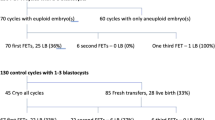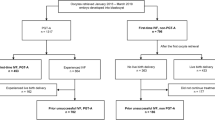Abstract
Purpose
To report the effects of blastocyst stage aneuploidy testing on clinical, gestational, and neonatal outcomes for patients of advanced maternal age undergoing IVF.
Methods
This is a single-center observational-cohort study with 2 years follow-up. The study includes a total of 2538 couples undergoing 2905 egg collections (control group), 308 (PGT-A), and 106 (drop-out group, consenting for PGT-A but withdrawing due to poor embryological outcome)
Results
Compared with control group, PGT-A showed improved clinical outcomes (live-birth rate per transferred embryo, LBR 40.3% vs 11.0%) and reduced multiple pregnancy rate (MPR, 0% vs 11.1%) and pregnancy loss (PL, 3.6% vs 22.6%). Drop-out group showed the worst clinical outcomes suggesting that abandoning PGT-A due to poor response to ovarian stimulation is not a favorable option. Cytogenetic analysis of product of conceptions and CVS/amniocentesis showed higher aneuploid pregnancy rates for control group regardless of embryo transfer strategy (0%, 17.9%, and 19.9%, for PGT-A, control day 5 and day 3, respectively). Multivariate analysis showed no negative impact of PGT-A-related interventions on cumulative delivery rate (26.3%, 95% CI 21.5–31.6 vs 24.0%, 95% CI 22.5–25.6 for PGT-A and control, respectively) and on neonatal outcomes.
Conclusion
PGT-A improves clinical outcomes, particularly by reducing pregnancy loss and chromosomally abnormal pregnancy for patients of advanced maternal age, with no major impact on cumulative live-birth rate (CLBR) per egg retrieval.



Similar content being viewed by others
References
Mastenbroek S, Repping S. Preimplantation genetic screening: back to the future. Hum Reprod. 2014:1846–50.
Dahdouh EM, Balayla J, Garcia-Velasco JA. Comprehensive chromosome screening improves embryo selection: a meta-analysis. Fertil Steril. 2015;104:1503–12.
Geraedts J, Sermon K. Preimplantation genetic screening 2.0: the theory. Mol Hum Reprod [Internet]. Oxford University Press; 2016;22:839–44. Available from: https://academic.oup.com/molehr/article-lookup/doi/10.1093/molehr/gaw033
Gleicher N, Orvieto R. Is the hypothesis of preimplantation genetic screening (PGS) still supportable? A review. J Ovarian Res. 2017:1–7.
Cox GF, Bürger J, Lip V, Mau UA, Sperling K, Wu B-L, et al. Intracytoplasmic sperm injection may increase the risk of imprinting defects. Am J Hum Genet. 2002;71:162–4.
DeBaun MR, Niemitz EL, Feinberg AP. Association of in vitro fertilization with beckwith-wiedemann syndrome and epigenetic alterations of LIT1 and H19. Am J Hum Genet. 2003;72:156–60.
Santos F, Hyslop L, Stojkovic P, Leary C, Murdoch A, Reik W, et al. Evaluation of epigenetic marks in human embryos derived from IVF and ICSI. Hum Reprod. 2010;25:2387–95.
Martins WP, Nastri CO, Rienzi L, van der Poel SZ, Gracia C, Racowsky C. Blastocyst vs cleavage-stage embryo transfer: systematic review and meta-analysis of reproductive outcomes. Ultrasound Obstet Gynecol. 2017:583–91.
Tannus S, Cohen Y, Son WY, Shavit T, Dahan MH. Cumulative live-birth rate following elective single blastocyst transfer compared with double blastocyst transfer in women aged 40 years and over. Reprod BioMed Online. 2017;35:733–8.
Styer AK, Wright DL, Wolkovich AM, Veiga C, Toth TL. Single-blastocyst transfer decreases twin gestation without affecting pregnancy outcome. Fertil Steril. 2008;89:1702–8.
Capalbo A, Bono S, Spizzichino L, Biricik A, Baldi M, Colamaria S, et al. Sequential comprehensive chromosome analysis on polar bodies, blastomeres and trophoblast: insights into female meiotic errors and chromosomal segregation in the preimplantation window of embryo development. Hum Reprod. 2013;28.
Rubio C, Bellver J, Rodrigo L, Castillón G, Guillén A, Vidal C, et al. In vitro fertilization with preimplantation genetic diagnosis for aneuploidies in advanced maternal age: a randomized, controlled study. Fertil Steril. 2017;107:1122–9.
Forman EJ, Hong KH, Ferry KM, Tao X, Taylor D, Levy B, et al. In vitro fertilization with single euploid blastocyst transfer: a randomized controlled trial. Fertil Steril. 2013;100.
Somigliana E, Busnelli A, Paffoni A, Vigano P, Riccaboni A, Rubio C, et al. Cost-effectiveness of preimplantation genetic testing for aneuploidies. Fertil Steril. 2019;111:1169–76.
Scott RT Jr, Ferry K, Su J, Tao X, Scott K, Treff NR. Comprehensive chromosome screening is highly predictive of the reproductive potential of human embryos: a prospective, blinded, nonselection study. Fertil Steril. 2012;97:870–5 Available from: http://www.ncbi.nlm.nih.gov/pubmed/22305103.
Scott RT Jr, Treff NR, Stevens J, Forman EJ, Hong KH, Katz-Jaffe MG, et al. Delivery of a chromosomally normal child from an oocyte with reciprocal aneuploid polar bodies. J Assist Reprod Genet. 2012;29:533–7 Available from: http://www.ncbi.nlm.nih.gov/pubmed/22460080.
Ubaldi FM, Cimadomo D, Capalbo A, Vaiarelli A, Buffo L, Trabucco E, et al. Preimplantation genetic diagnosis for aneuploidy testing in women older than 44 years: a multicenter experience. Fertil Steril. 2017;107.
Capalbo A, Hoffmann ER, Cimadomo D, Ubaldi FM, Rienzi L. Human female meiosis revised: new insights into the mechanisms of chromosome segregation and aneuploidies from advanced genomics and time-lapse imaging. Hum Reprod Update. 2017;23.
Hassold T, Hunt P. To err (meiotically) is human: the genesis of human aneuploidy. Nat Rev Genet. 2001;2:280–91 Available from: http://www.nature.com/articles/35066065.
Bettio D, Capalbo A, Albani E, Rienzi L, Achille V, Venci A, et al. 45,X product of conception after preimplantation genetic diagnosis and euploid embryo transfer: evidence of a spontaneous conception confirmed by DNA fingerprinting. Reprod Biol Endocrinol. 2016;14.
Levi-Setti PE, Zerbetto I, Baggiani A, Zannoni E, Sacchi L, Smeraldi A, et al. An observational retrospective cohort trial on 4,828 IVF cycles evaluating different low prognosis patients following the Poseidon criteria. Front Endocrinol (Lausanne). 2019;10.
Levi-Setti PE, Menduni F, Smeraldi A, Patrizio P, Morenghi E, Albani E. Artificial shrinkage of blastocysts prior to vitrification improves pregnancy outcome: analysis of 1028 consecutive warming cycles. J Assist Reprod Genet [Internet]. Springer US; 2016;33:461–6. Available from: http://link.springer.com/10.1007/s10815-016-0655-y
Tedeschi G, Albani E, Borroni EM, Parini V, Brucculeri AM, Maffioli E, et al. Proteomic profile of maternal-aged blastocoel fluid suggests a novel role for ubiquitin system in blastocyst quality. J Assist Reprod Genet. 2017;34:225–38.
Cobo A, De Los Santos MJ, Castellò D, Gámiz P, Campos P, Remohí J. Outcomes of vitrified early cleavage-stage and blastocyst-stage embryos in a cryopreservation program: Evaluation of 3,150 warming cycles. Fertil Steril. 2012;98.
Capalbo A, Treff NR, Cimadomo D, Tao X, Upham K, Ubaldi FM, et al. Comparison of array comparative genomic hybridization and quantitative real-time PCR-based aneuploidy screening of blastocyst biopsies. Eur J Hum Genet. 2015;23.
Murugappan G, Shahine LK, Perfetto CO, Hickok LR, Lathi RB. Intent to treat analysis of in vitro fertilization and preimplantation genetic screening versus expectant management in patients with recurrent pregnancy loss. Hum Reprod. 2016.
Rienzi L, Capalbo A, Vajta G, Ubaldi FM. PGS for recurrent pregnancy loss: Still an open question. Hum Reprod. 2017:476–7.
Levi Setti PE, Moioli M, Smeraldi A, Cesaratto E, Menduni F, Livio S, et al. Obstetric outcome and incidence of congenital anomalies in 2351 IVF/ICSI babies. J Assist Reprod Genet. 2016;33:711–7.
Castillo CM, Horne G, Fitzgerald CT, Johnstone ED, Brison DR, Roberts SA. The impact of IVF on birthweight from 1991 to 2015: a cross-sectional study. Hum Reprod. 2019;34:920–31.
Ubaldi FM, Capalbo A, Colamaria S, Ferrero S, Maggiulli R, Vajta G, et al. Reduction of multiple pregnancies in the advanced maternal age population after implementation of an elective single embryo transfer policy coupled with enhanced embryo selection: pre- and post-intervention study. Hum Reprod. 2015;30.
Author information
Authors and Affiliations
Corresponding author
Additional information
Publisher’s note
Springer Nature remains neutral with regard to jurisdictional claims in published maps and institutional affiliations.
Electronic supplementary material
ESM 1
(DOCX 51 kb)
Rights and permissions
About this article
Cite this article
Sacchi, L., Albani, E., Cesana, A. et al. Preimplantation Genetic Testing for Aneuploidy Improves Clinical, Gestational, and Neonatal Outcomes in Advanced Maternal Age Patients Without Compromising Cumulative Live-Birth Rate.. J Assist Reprod Genet 36, 2493–2504 (2019). https://doi.org/10.1007/s10815-019-01609-4
Received:
Accepted:
Published:
Issue Date:
DOI: https://doi.org/10.1007/s10815-019-01609-4




